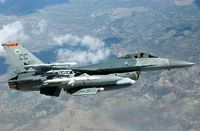F-16 FIGHTING FALCON - Mission: The F-16 Fighting Falcon is a compact, multi-role fighter aircraft. It is highly maneuverable and has proven itself in air-to-air combat and air-to-surface attack. It provides a relatively low-cost, high-performance weapon system for the United States and allied nations.
Features : In an air combat role, the F-16's maneuverability and combat radius (distance it can fly to enter air combat, stay, fight and return) exceed that of all potential threat fighter aircraft. It can locate targets in all weather conditions and detect low flying aircraft in radar ground clutter. In an air-to-surface role, the F-16 can fly more than 500 miles (860 kilometers), deliver its weapons with superior accuracy, defend itself against enemy aircraft, and return to its starting point. An all-weather capability allows it to accurately deliver ordnance during non-visual bombing conditions.
In designing the F-16, advanced aerospace science and proven reliable systems from other aircraft such as the F-15 and F-111 were selected. These were combined to simplify the airplane and reduce its size, purchase price, maintenance costs and weight. The light weight of the fuselage is achieved without reducing its strength. With a full load of internal fuel, the F-16 can withstand up to nine G's -- nine times the force of gravity -- which exceeds the capability of other current fighter aircraft.
High Resolution Image Download Full High Resolution Image
Photo, Text Disclaimer:
1. Air Force Link is provided as a public service by the Office of the Secretary of Air Force (Public Affairs).
2. Information presented on Air Force Link is considered public information and may be distributed or copied. Use of appropriate byline/photo/image credits is requested.
Generally speaking, works created by U.S. Government employees are not eligible for copyright protection in the United States. See Circular 1 "COPYRIGHT BASICS" from the U.S. Copyright Office.
The cockpit and its bubble canopy give the pilot unobstructed forward and upward vision, and greatly improved vision over the side and to the rear. The seat-back angle was expanded from the usual 13 degrees to 30 degrees, increasing pilot comfort and gravity force tolerance. The pilot has excellent flight control of the F-16 through its "fly-by-wire" system. Electrical wires relay commands, replacing the usual cables and linkage controls. For easy and accurate control of the aircraft during high G-force combat maneuvers, a side stick controller is used instead of the conventional center-mounted stick. Hand pressure on the side stick controller sends electrical signals to actuators of flight control surfaces such as ailerons and rudder.
Avionics systems include a highly accurate inertial navigation system in which a computer provides steering information to the pilot. The plane has UHF and VHF radios plus an instrument landing system. It also has a warning system and modular countermeasure pods to be used against airborne or surface electronic threats. The fuselage has space for additional avionics systems.
Related: Public Domain Clip Art Archive June - July 2005 and Aircraft
Nanotechnology Today or Public Domain Clip Art and Republican National Convention Blog


No comments:
Post a Comment